
Science Today
The Theoretical Interpretation of Spacetime
And Their Atmospheric Composition
Charles William Johnson
Generally, the astronomical unit (AU) is measured as of the distance of the Earth from the Sun, which is often given as 92955800 miles (to greater or lesser accuracy in the average). An even more intriguing number, 959.62 is offered by some sources as a measurement "at unit distance", which suggests a similarity with the Nineveh number, 1959552/fractal.
The aspect that we shall treat in this extract, however, concerns the use of Earth as always representing the unit one (1.0) on the scale of distances, since it has been taken to be the astronomical unit (AU) employed in astronomy today. When the Earth's distance from the Sun is taken as the unit one, then all of the other planets are measured in terms of a ratio of that particular number. In doing so, an apparent relationship of proportion is obtained. However, one might consider the selection of the distance of the Earth, the third planet in our solar system from the Sun, as representing an arbitrary choice.
From the perspective of ourselves, as human beings living on planet Earth, the choice would by no means appear to be arbitrary. But, from the perspective of the behavior of matter and energy, one might make a case for the choice of selection being better exercised by utilizing the planet Mercury as the unit one, given the fact that it is the closest planet to the Sun in our solar system.
The corresponding numbers for the proportional representation, utilizing the planet Earth as the unit one for measurement, are given below:
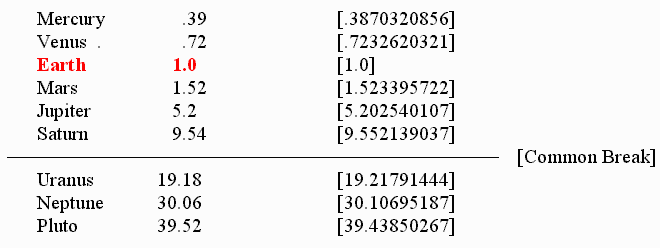
We have employed the numbers rounded off that are generally cited in textbooks and almanacs. From the previous table, generally the break is shown to exist between Saturn and Uranus. One set of precise numbers is given in the brackets, but these would vary as the interpretations of the mean distances vary themselves. Ultimately, one would choose numbers and then make the necessary adjustments depending upon the set of numbers chosen.
Another alternative set of numbers, brought to my attention by Mr. Jim Branson would produce the following modifications in the numbers:
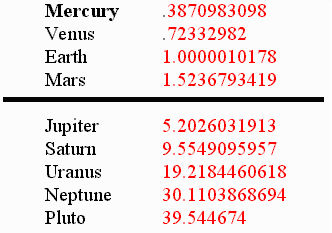
These numbers would produce distinct relationships, but all within the mean distances. For example, the numbers would produce a range relating to Venus' orbital timing.
1.846153846 halves down to .057692308 [maya long count fractal]
1.868594626 halves down to .0058393582
Nevertheless, the range of numbers is what interests us as of the planet Mercury being identified as the unit one for the measurement.
With such a set of numbers, a sense of proportion is offered, with the defining unit of measurement falling within the extremes of the planets revolving around the Sun, falling upon the third planet within the system, the Earth [1.0]. However, on the other hand, we shall utilize the planet Mercury as the unit one, whose mean distance from the Sun is cited as 36,000,000 miles, for the astronomical unit in this case. Therefore, a distinct sense of proportion obtains and the numbers appear to make more sense in computations regarding the orbital times. Furthermore, one cannot help but notice the direct relationship that the figure 36,000,000 holds for the ancient reckoning system and the maya long count (360c) nor, for the ancient kemi calendrical count (360c). One might even suspect that the ancients employed this particular distance given the nature of the ancient reckoning system itself.
The numbers/fractals may vary, depending upon the measurements taken for the system. For example, if we take the 92955800 miles often given for the Earth measurement, then, in relation to the 36,000,000 miles cited for Mercury, all of the the ratios shall change.
92955800 / 36000000 = 2.582105556
The problem in the computations comes regarding the mean distances and their averages, given the fact that we are not dealing with perfect circles in the planets' orbits. But, we shall understand that as the numbers selected change, the ratios change and adjustments must be made. For our purposes, we shall employ some of the numbers commonly offered in textbooks on astronomy. The 93000000 miles figure often cited would also produce a distinct ratio: 93000000 / 36000000 = 2.58333333. The significant point to understand in this brief extract concerns the use of the distance of Mercury from the Sun as the astronomical unit (AU) ---36,000,000 miles, and not the 93,000,000 miles commonly employed. It is this selective choice that shall determine the patterns discerned below.
Let us offer the numbers as of the system of measurement utilizing the planet Mercury as the unit one (1.0). The corresponding numbers for the ratios would then be:
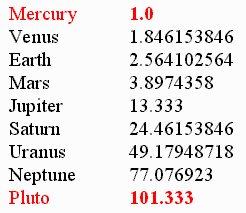
Now, a sense of proportion becomes even more definite and comprehensible. The system now stretches from 1.0 to 101.333, almost a perfect 1 – 100 system of proportion; something that mentally, we can easily grasp.
Initially, we may also observe a cut-off point within the progression, whereby a significant jump appears between Mars and Jupiter: This jump in distance suggests a mid-point between the two planets, and also suggests a pattern. This particular pattern, as we shall observe, also appears to follow the atmospheric composition of the different planets, as we shall discuss below.

It were as though two distinct progressions appear within the pattern:
a) 1.0 to 3.8974358
b) 13.333 to 101.333
Now, let us review the atmospheric composition of the planets:
Mercury:
Major: 42% Oxygen (O2); 29% Sodium (Na); 22% Hydrogen (H2); 6% Helium
(He); 0.5% Potassium (K); Minor: possible trace amounts of Argon (Ar),
Carbon Dioxide (CO2), Water (H2O), Nitrogen (N2), Xenon (Xe), Krypton
(Kr), Neon (Ne).
Venus:
Major: 96.5% Carbon Dioxide (CO2); 3.5% Nitrogen (N2); Minor (ppm):
Sulphur Dioxide (SO2) - 150; Argon (Ar) - 70; Water (H2O); Carbon Monoxide
(CO) - 17; Helium (He) - 12; Neon (Ne) - 7.
Earth:
Major: 78.084% Nitrogen (N); 20.946% Oxygen (O2); Minor (ppm): Argon
(Ar) - 9340; Carbon Dioxide (CO2) - 350; Neon (Ne) - 18.18; Helium (He)
- 5.24; CH4 - 1.7; Krypton (Kr) - 1.14; Hydrogen (H2) - 0.55.
Mars:
Major: Carbon Dioxide (CO2) - 95.32%; Nitrogen (N2) - 2.7%; Argon (Ar)
- 1.6%; Oxygen (O2) - 0.13%; Carbon Monoxide (CO) - 0.08% Minor (ppm):
Water (H2O) - 210; Nitrogen Oxide (NO) - 100; Neon (Ne) - 2.5; Hydrogen-Deuterium-Oxygen
(HDO) - 0.85; Krypton (Kr) - 0.3); Xenon (Xe) - 0.08.
Jupiter:
Major: Molecular hydrogen (H2) - 89.8% (2.0%); Helium (He) - 10.2%
(2.0%) Minor (ppm): Methane (CH4) - 3000 (1000); Ammonia (NH2) - 260 (40);
Hydrogen Deuteride (HD) - 28 (10); Ethane (C2H6) - 5.8 (1.5) (uncertainty
in parentheses)
Saturn:
Major: Molecular hydrogen (H2) - 96.3% (2.4%); Helium (He) - 3.25%
(2.4%); Minor (ppm): Methane (CH4) - 4500 (2000); Ammonia (NH3) - 125
(75); Hydrogen Deuteride (HD) - 110 (58); Ethane (C2H6) - 7 (1.5) (uncertainty
in parentheses)
Uranus:
Major: Molecular hydrogen (H2) - 82.5% (3.3%); Helium (He) - 15.2%
(3.3%) Minor (ppm): Hydrogen Deuteride (HD) - ~148
Neptune:
Major: Molecular hydrogen (H2) - 80.0% (3.2%); Helium (He) - 19.0%
(3.2%); Minor (ppm): Hydrogen Deuteride (HD) - ~192; Ethane (C2H6) - ~1.5
(uncertainty in parentheses)
Pluto:
Methane (CH4); Nitrogen (N2)
Major Elements of Atmospheric Composition
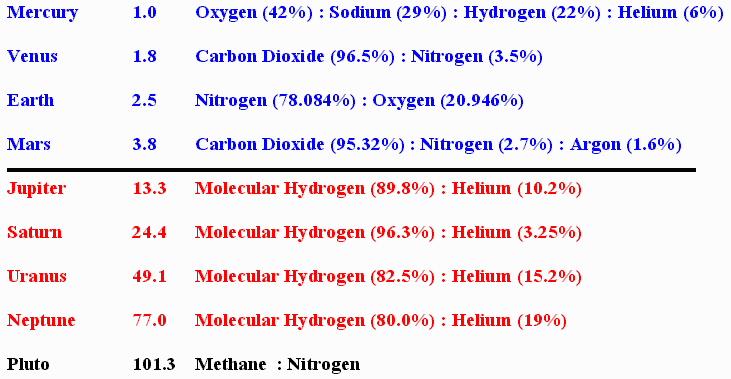
With this illustration, it is now possible to view the two distinct progressions and their corresponding atmospheric compositions for each planet.
The use of the unit one for Mercury on the scale also allows for many other observations regarding the ancient reckoning system.
The ancient kemi system is based upon the 108c, and one could even suspect a relationship with the previous system of notation. Consider, for example, the 108c in relation to Venus' synodic measurement, that is often cited in the historical record.
108 / 585 = .184615385
This fractal expression reflects exactly the proportional relationship regarding the distance of Mercury and Venus (1.846153846), as we have seen above.
Furthermore, the 1846153(846153) number/fractal doubles to an historically significant number/fractal:
| 1.846153846 | |
| 7.384615384 | |
| 14.76923077 | |
| 29.53846154 | |
| 59.07692307 | |
| ... | |
| 7561.846153 | [Note: the baseline 756c of the Great Pyramid] |
Note how the 576c fractal occurs with the 1846153 factor.
| Hence, 7561.846153 / 1.846153846 | = | 4096 | |
| 2048 | |||
| 1024 | |||
| 512 | |||
| 256 | [Note: constant number series] |
The constant number series cuts off the 756c at a very interesting level: thirteen (13).
1, 2, 4, 8, 16, 32, 64, 128, 256, 512, 1024, 2048, 4096, is the thirteenth number on the series. The significance of the number thirteen in the ancient reckoning system has been discussed extensively in the Earth/matriX essays.
From the aforementioned, one cannot only utilize, then, the ancient reckoning numbers/fractals for computations of orbital times of the planets, but also for distances.
The fractal number that corresponds to the planet Earth, 2.56410256 is suggestive of the ancient 1001c number/fractal, which produces mirrored numbers.
1001 x 256 = 256256
1000001 x 256 = 256000256 [ - 256410256 = 410000]
By utilizing the planet Mercury as the unit one for the proportional relationship of the system of planets, then, the planet Venus reflects a numerical expression that is to be found in the ancient reckoning system (1.846153846). Furthermore, the planet Earth, on this same scale, now occupies a numerical expression that reflects the concept of a constant number series (256c).
From this perspective, were the planet Earth to be employed as an even-numbered constant series, then the relationship with Venus would vary theoretically. If Earth were actually the 2.56c constant number series, then Venus would represent the numerical expression of 1.8432, which forms part of the maya long count.
| 2.56 x .72 = | 1.8432 |
| .9216 | |
| .4608 | |
| .2304 | |
| .1152 | |
| .576 | |
| .288 | |
| .144 | |
| .36 |
In other words, in this theoretical system, Mercury represents the unit one (1.0); Venus represents the maya long count (1.8432); and Earth represents the constant number series (2.56c). This specific relationship reflects the very nature of the workings of the maya long count itself.
The entire, theoretically ideal system would be as follows:

Far too many relationships exist between the actual and the theoretically ideal numbers, in relation to the ancient reckoning system, to draw attention to them in this short extract. But, just a few may be cited:
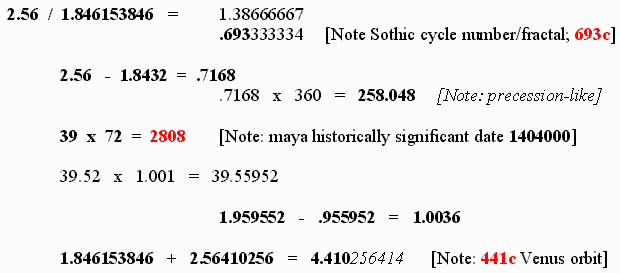
By utilizing the numbers/fractals between the actual system (where Mercury is taken as unit one), and the theoretically ideal system (where Earth is 2.56c), one is able to make adjustments in the computations. These adjustments reveal direct relationships with the ancient reckoning system. The ease with which one flows from computing distance and time for the planets, leads one to believe that the ancient reckoning system may have done just that. The ancients may have been computing not only time, but as we have frequently suggested, they may have been computing distance as well.
And, it should be stated, that if they did not do so, well, at the very least, their reckoning system could have done such computations without any problem.
Consider:

And, the most obvious relationship between Earth and Venus is:
2.56410256 / 1.846153846 = 1.388888889
and, we know what this particular number is capable of doing, for example, regarding the maya companion numbers:
1385540 / 1366560 = 1388888889
In this expression, we may be witnessing a symbolic expression of the planet Earth (1385540) and the planet Venus (1366560), given the proportional relationship of the numbers and their corresponding relationship to the distance of these planets from the Sun.
This may explain why the maya companion number 1385540 relates to the 365c of Earth, but not to the 360c, which may represent Venus.
1385540 / 365 = 3796 [Note double the calendar round fractal, 18980c]
but,
1385540 / 360 = 3848.7222222 [An unpleasant fraction]
1366560 / 365 = 3744
1366560 / 360 = 3796
Then, note, however:
| 3848.7222222 / 2 | = | 1924.3611 | |
| 962.18055 | |||
| 481.090275 | [Note the height of the Great Pyramid is computed to be 481.5 feet] |
The patterns become obvious:
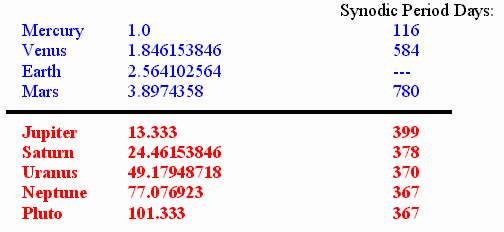

Now, consider, the proportion as of the measurement of miles in distance:
| 36 / 3675 | = | .009795918 |
| .019591837 | ||
| Mercury 36 / .01959552 | = | 1837.154615 Pluto |
| Mercury 36 / .00979776 | = | 3674.30923 Pluto |
In this sense, one could imagine the Nineveh number/fractal serving as a factor for the entire solar system of planetary bodies. One cannot but suspect an underlying relationship of the 1959552 Nineveh number/fractal.
Now, if the entire system from Mercury to Pluto represents the Nineveh number/fractal of 1959552, then we may know the relationship to the apparent break between Mars and Jupiter. Consider the following:
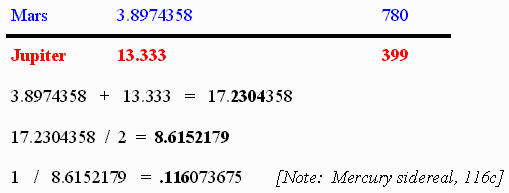
Observations:
The Astronomical Unit: 36,000,000 miles
No matter where one looks, significant numbers appear when a system of computations follows the numbers and fractals of the ancient reckoning system. We have seen how the pattern of the distance of the planets, when based on the planet Mercury as the unit one, reflects a similarity with the pattern established by the atmospheric composition of the planets. The astronomical unit (AU) based upon the mean distance of the planet Mercury from the Sun reflects approximately 36,000,000 miles, a number/fractal that is directly relevant to the ancient reckoning system. The two internal progressions of the pattern established by the distances of the planets from the Sun, reflect a similar division with regard to the elements that make up the atmospheric composition of the planets.
***
[PDF] Phi Patterns in Nature and Beyond
from the Sun and their Atmospheric Com- position.” The conjecture hinges upon the inclusion
of Ceres as a dwarf planet. ... earthmatrix. ...
©2000-2015 Copyrighted by Charles William Johnson. email: johnson@earthmatrix.com. "The Distance of the Planets from the Sun And Their Atmospheric Composition" All rights reserved. Reproduction prohibited. 13 September 2000
|
The 3-4-5 perfect right triangle reflects an angle of 36 degrees 52 minutes This calls to mind the 360c day-count and the 52c year-count of the ancient Mesoamerican peoples. cwj |
| Home | Books | Author |